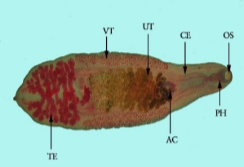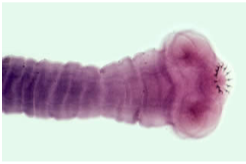6.2: Introduction
- Page ID
- 40184
Helminths are a group of worms most often referred to as the parasitic worms—as opposed to earthworms, polychaete worms, etc. Worms are multicellular, eukaryotic, invertebrate animals. Most are macroscopic, but have microscopic life stages. They are complex organisms with organs and organ systems. In addition, they usually have complex life-cycles which may include different larval and cyst stages, and multiple hosts.
Terms to know
Intermediate host: the host in which larval development occurs
Definitive host: the host in which mature organisms live and undergo sexual reproduction
Hermaphroditic: male and female sex organs occur in the same individual worm (most commonly in cestodes and many trematodes).
Parasite: an organism that lives in or on another organism (the host), to the detriment of the host.
Taxonomy: The taxonomy of organisms is under constant review. We will use the following taxonomy to group the helminthes we will observe.
|
Phylum Platyhelminthes (flatworms) |
Phylum Nematoda (roundworms) |
|
|---|---|---|
|
Class Trematoda |
Class Cestoda |
|
|
-Flukes -Leaf shaped -Mollusk is usually the intermediate host(s) -Vertebrate is usually the definitive host -Digestive system
Adult of C. sinensis stained with carmine. Clearly visible in this image are the oral sucker (OS), pharynx (PH), ceca (CE), acetabulum, or ventral sucker (AC), uterus (UT), vitellaria (VT) and testes (TE). www.cdc.gov/dpdx/clonorchi |
-Tapeworms -Long, ribbon like bodies -Scolex for attachment, with reproductive segments called proglottids -Usually also require two or more hosts -No digestive system
Scolex of T. solium. Note the four large |
-Roundworms -Cylindrical -Usually only one host -Complete digestive system -Very diverse and numerous group. -Many free-living, predatory, and parasitic types.
Adult Ascaris lumbricoides |
Contributors and Attributions
Kelly C. Burke (College of the Canyons)





